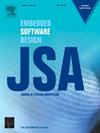An FPGA-based bit-level weight sparsity and mixed-bit accelerator for neural networks
IF 4.1
2区 计算机科学
Q1 COMPUTER SCIENCE, HARDWARE & ARCHITECTURE
引用次数: 0
Abstract
Bit-level weight sparsity and mixed-bit quantization are regarded as effective methods to improve the computing efficiency of convolutional neural network (CNN) accelerators. However, irregular sparse matrices will greatly increase the index overhead and hardware resource consumption. Moreover, bit-serial computing (BSC) is usually adopted to implement bit-level weight sparsity on accelerators, and the traditional BSC leads to uneven utilization of DSP and LUT resources on the FPGA platform, thereby limiting the improvement of the overall performance of the accelerator. Therefore, in this work, we present an accelerator designed for bit-level weight sparsity and mixed-bit quantization. We first introduce a non-linear quantization algorithm named bit-level sparsity learned quantizer (BSLQ), which can maintain high accuracy during mixed quantization and guide the accelerator to complete bit-level weight sparse computations using DSP. Based on this algorithm, we implement the multi-channel bit-level sparsity (MCBS) method to mitigate irregularities and reduce the index count associated with bit-level sparsity. Finally, we propose a sparse weight arbitrary basis scratch pad (SWAB SPad) method that enables retrieval of compressed weights without fetching activations, which can save 30.52% of LUTs and 64.02% of FFs. Experimental results demonstrate that when quantizing ResNet50 and VGG16 using 4/8 bits, our approach achieves accuracy that is comparable to or even better than 32-bit (75.98% and 73.70% for the two models). Compared to the state-of-the-art FPGA-based accelerators, this accelerator achieves up to 5.36 times DSP efficiency improvement and provides 8.87 times energy efficiency improvement.
基于fpga的神经网络位级权重稀疏性和混合位加速器
比特级权稀疏和混合比特量化被认为是提高卷积神经网络(CNN)加速器计算效率的有效方法。然而,不规则稀疏矩阵会大大增加索引开销和硬件资源消耗。此外,通常采用比特串行计算(BSC)在加速器上实现比特级的权重稀疏性,传统的BSC导致FPGA平台上DSP和LUT资源的利用不均衡,从而限制了加速器整体性能的提升。因此,在这项工作中,我们提出了一个专为比特级权重稀疏和混合比特量化而设计的加速器。首先介绍了一种非线性量化算法——比特级稀疏学习量化器(BSLQ),该算法可以在混合量化过程中保持较高的精度,并引导加速器利用DSP完成比特级权值的稀疏计算。在此基础上,我们实现了多通道比特级稀疏(MCBS)方法,以减轻不规则性并减少与比特级稀疏相关的索引计数。最后,我们提出了一种稀疏权重任意基刮擦板(SWAB SPad)方法,该方法可以在不获取激活的情况下检索压缩后的权重,可以节省30.52%的lut和64.02%的FFs。实验结果表明,当使用4/8位量化ResNet50和VGG16时,我们的方法达到了与32位相当甚至更好的精度(两种模型分别为75.98%和73.70%)。与最先进的基于fpga的加速器相比,该加速器实现了高达5.36倍的DSP效率提升,提供了8.87倍的能效提升。
本文章由计算机程序翻译,如有差异,请以英文原文为准。
求助全文
约1分钟内获得全文
求助全文
来源期刊

Journal of Systems Architecture
工程技术-计算机:硬件
CiteScore
8.70
自引率
15.60%
发文量
226
审稿时长
46 days
期刊介绍:
The Journal of Systems Architecture: Embedded Software Design (JSA) is a journal covering all design and architectural aspects related to embedded systems and software. It ranges from the microarchitecture level via the system software level up to the application-specific architecture level. Aspects such as real-time systems, operating systems, FPGA programming, programming languages, communications (limited to analysis and the software stack), mobile systems, parallel and distributed architectures as well as additional subjects in the computer and system architecture area will fall within the scope of this journal. Technology will not be a main focus, but its use and relevance to particular designs will be. Case studies are welcome but must contribute more than just a design for a particular piece of software.
Design automation of such systems including methodologies, techniques and tools for their design as well as novel designs of software components fall within the scope of this journal. Novel applications that use embedded systems are also central in this journal. While hardware is not a part of this journal hardware/software co-design methods that consider interplay between software and hardware components with and emphasis on software are also relevant here.
 求助内容:
求助内容: 应助结果提醒方式:
应助结果提醒方式:


